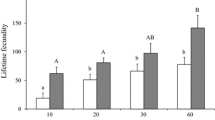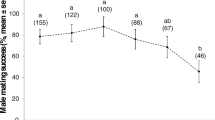Abstract
The seminal fluid that accompanies sperm in ejaculates has been shown or suggested to affect sperm competition and paternity success of insects by preventing female remating, inducing oviposition, and forming mating plugs. In Atta leafcutter ants, queens have multiple mates but never remate later in life, although they may live and produce fertilized eggs for several decades. The mating biology and life history of these ants therefore suggests that the major function of seminal fluid is to maximize sperm viability during copulation, sperm transfer, and initial sperm storage. We tested this hypothesis by comparing the viability of testis sperm and ejaculated sperm (mixed with seminal fluid) and found a significant positive effect of seminal fluid on sperm viability. We further quantified this positive effect by adding accessory gland secretion (a major component of seminal fluid) in a dilution series, to show that minute quantities of accessory gland secretion achieve significant increases in sperm viability. Sperm stored by queens for 1 year benefited in a similar way from being exposed to accessory gland compounds after dissection in control saline solution. Our results provide the first empirical evidence that seminal fluid is important for the production of viable ejaculates and that the accessory glands of Atta males—despite their small size—are functional and produce a very potent secretion.



Similar content being viewed by others
References
Baer B (2003) Bumblebees as model organisms to study male sexual selection in social insects. Behav Ecol Sociobiol 54:521
Baer B (2005) Sexual selection in Apis bees. Apidologie 36:187–200
Baer B, Boomsma JJ (2004) Male reproductive investment and queen mating-frequency in fungus-growing ants. Behav Ecol 15:426–432
Baer B, Boomsma JJ (2006) Mating biology of the leaf-cutting ants Atta colombica and Atta cephalotes. J Morphol 267:1165–1171
Baer B, Morgan E-D, Schmid-Hempel P (2001) A nonspecific fatty acid within the bumblebee mating plug prevents females from remating. Proc Natl Acad Sci U S A 98:3926–3928
Baer B, Armitage S, Boomsma JJ (2006) Sperm storage induces an immunity cost in ants. Nature 44:872–875
Bernasconi G, Hellriegel B, Heyland A, Ward PI (2002) Sperm survival in the female reproductive tract in the fly Scathophaga stercoraria (L.). J Insect Physiol 48:197–203
Boomsma JJ (2007) Kin selection versus sexual selection: why the ends do not meet. Curr Biol 17:R673–R683
Boomsma JJ, Baer B, Heinze J (2005) The evolution of male traits in social insects. Annu Rev Entomol 50:395–420
Chapman T, Davies SJ (2004) Functions and analysis of the seminal fluid proteins of male Drosophila melanogaster fruit flies. Peptides 25:1477–1490
Chen PS (1984) The functional morphology and biochemistry of insect male accessory glands and their secretions. Annu Rev Entomol 29:233–255
Cole B (1983) Multiple mating and the evolution of social behavior in the hymenoptera. Behav Ecol Sociobiol 12:191–201
Collins AM (2000) Survival of honey bee (Hymenoptera: Apidae) spermatozoa stored at above-freezing temperatures. J Econ Entomol 93:568–571
Collins AM, Donoghue AM (1999) Viability assessment of honey bee Apis mellifera sperm using dual fluorescent staining. Theriogenology 51:1513–1523
Collins AM, Caperna TJ, Williams V, Garrett WM, Evans JD (2006) Proteomic analyses of male contributions to honey bee sperm storage and mating. Insect Mol Biol 15:541–549
Colonello NA, Hartfelder K (2005) She’s my girl—male accessory gland products and their function in the reproductive biology of social bees. Apidologie 36:231–244
Damiens D, Bressac C, Brillard J-P, Chevrier C (2002) Qualitative aspects of sperm stock in males and females from Eupelmus orientalis and Dinarmus basalis (Hymenoptera: Chalcidoidea) as revealed by dual fluorescence. Physiol Entomol 27:97–102
Demary K (2005) Sperm storage and viability in Photinus fireflies. J Insect Physiol 51:837–841
Fjerdingstad EJ, Boomsma JJ (1998) Multiple mating increases the sperm stores of Atta colombica leafcutter ant queens. Behav Ecol Sociobiol 42:257–261
Fjerdingstad EJ, Boomsma JJ, Thorén P (1998) Multiple paternity in the leafcutter ant Atta colombica—a microsatellite DNA study. Heredity 80:118–126
Fry CL, Wilkinson GS (2004) Sperm survival in female stalk-eyed flies depends on seminal fluid and meiotic drive. Evolution 58:1622–1626
García-González F, Simmons LW (2005) Sperm viability matters in insect sperm competition. Curr Biol 15:271–275
Gillott C (2003) Male accessory gland secretions: modulators of female reproductive physiology and behavior. Annu Rev Entomol 48:163–184
Hodgson D, Hosken D (2006) Sperm competition promotes the exploitation of rival ejaculates. J Theor Biol 243:230–234
Hölldobler B, Bartz SH (1985) Sociobiology of reproduction in ants. In: Hölldobler B, Lindauer M (eds) Experimental behavioural ecology and sociobiology. Gustav Fischer Verlag, Stuttgart, pp 237–257
Hunter FM, Birkhead TR (2002) Sperm viability and sperm competition in insects. Curr Biol 12:121–123
Keller L (1998) Queen lifespan and colony characteristics in ants and termites. Insectes Soc 45:235–246
Koeniger N, Koeniger G (1991) An evolutionary approach to mating behaviour and drone copulatory organs in Apis. Apidologie 22:581–590
Koeniger N, Koeniger G, Wongsiri S (1989) Mating and sperm transfer in Apis florea. Apidologie 20:413–418
Kubli E (2003) Sex-peptides: seminal peptides of the Drosophila male. CMLS Cell Mol Life Sci 60:1689–1704
Mikheyev AS (2003) Evidence for mating plugs in the fire ant Solenopsis invicta. Insectes Soc 50:401–402
Poiani A (2006) Complexity of a seminal fluid: a review. Behav Ecol Sociobiol 60:289–310
Ravi Ram K, Wolfner MF (2007) Seminal influences: Drosophila Acps and the molecular interplay between males and females during reproduction. Integr Comp Biol 47:427–445
Sauter A, Brown MJF, Baer B, Schmid-Hempel P (2001) Males of social insects can prevent queens from multiple mating. Proc R Soc Lond B, Biol Sci 268:1449–1454
Schley P (1987) Einführung in die Technik der instrumentellen Besamung von Bienenköniginnen. Köhler Offset KG, Giessen
Simmons LW (2001) Sperm competition and its evolutionary consequences in the insects. Princeton University Press, Princeton
Thomas ML, Simmons LW (2007) Male crickets adjust the viability of their sperm in response to female mating status. Am Nat 170:190–195
Weber NA (1972) Gardening ants, the attines. The American Philosophical Society, Philadelphia
Woyke J (1983) Dynamics of entry of spermatozoa into the spermatheca of instrumentally inseminated queen honey bees. J Apicult Res 22:150–154
Yapici N, Kim YJ, Ribeiro C, Dickson BJ (2008) A receptor that mediates the post-mating switch in Drosophila reproductive behaviour. Nature 451:33–37
Acknowledgements
We thank Aniek Ivens and Jens Broch for collecting ants in the field, David Nash for statistical support, Francisco García-González for assistance with the Live/Dead™ protocol, and Leigh Simmons for valuable comments on the manuscript. We thank the Smithsonian Tropical Research Institute in Panama for facilities and logistic support and the Autoridad Nacional de Ambiente (ANAM) for issuing collecting and export permits. This work was supported by grants from the Danish National Research Foundation to SPAdB and JJB and an Australian Research Council Fellowship to BB.
Author information
Authors and Affiliations
Corresponding author
Additional information
Responsible editor: J. Heinze
Rights and permissions
About this article
Cite this article
den Boer, S.P.A., Boomsma, J.J. & Baer, B. Seminal fluid enhances sperm viability in the leafcutter ant Atta colombica . Behav Ecol Sociobiol 62, 1843–1849 (2008). https://doi.org/10.1007/s00265-008-0613-5
Received:
Revised:
Accepted:
Published:
Issue Date:
DOI: https://doi.org/10.1007/s00265-008-0613-5




